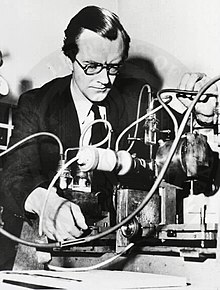Maurice Wilkins
| Maurice Wilkins | |
|---|---|

Maurice Wilkins with one of the cameras he developed specially for X-ray diffraction studies at King's College London
|
|
| Born | Maurice Hugh Frederick Wilkins 15 December 1916 Pongaroa, Wairarapa, New Zealand |
| Died | 5 October 2004 (aged 87) Blackheath, London |
| Fields | Physics, Molecular biology |
| Institutions |
King's College London The University of Birmingham University of California, Berkeley University of St Andrews |
| Alma mater |
St John's College, Cambridge University of Birmingham |
| Known for | X-ray diffraction, DNA |
| Notable awards |
|
Maurice Hugh Frederick Wilkins CBE FRS (15 December 1916 – 5 October 2004) was a New Zealand-born British physicist and molecular biologist, and Nobel laureate whose research contributed to the scientific understanding of phosphorescence, isotope separation, optical microscopy and X-ray diffraction, and to the development of radar. He is best known for his work at King's College London on the structure of DNA.
Wilkins' work on DNA falls into two distinct phases. The first was in 1948–50, when his initial studies produced the first clear X-ray images of DNA, which he presented at a conference in Naples in 1951 attended by James Watson. During the second phase, 1951–52, Wilkins produced clear "B form" "X" shaped images from squid sperm, images he sent to James Watson and Francis Crick, causing Watson to write "Wilkins... has obtained extremely excellent X-ray diffraction photographs" [of DNA].
In 1953 Wilkins' colleague Rosalind Franklin instructed Raymond Gosling to hand over to Wilkins a high quality image of "B" form DNA (Photo 51), which she had made in 1952 but had “put it aside” as she was leaving King's College London. Wilkins imprudently showed it to Watson. This image, along with the knowledge that Linus Pauling had proposed an incorrect structure of DNA, “mobilised” Watson and Crick to restart model building. With additional information from research reports of Wilkins and Franklin, obtained via Max Perutz, Watson and Crick correctly described the double-helix structure of DNA in 1953.
...
Wikipedia
